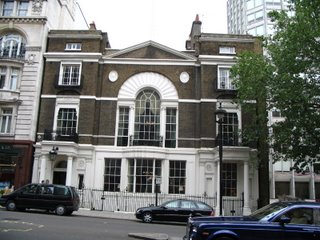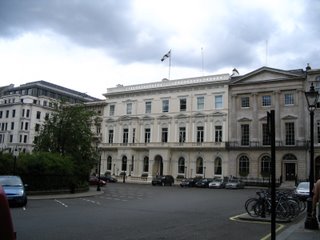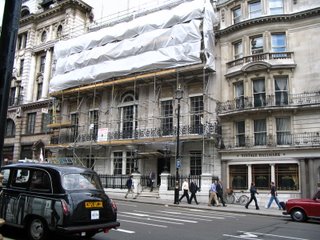First some exciting news!
http://www.rio-reviewers.com/rae/index.html
RIO - Reviewers International Organization - www.rio-reviewers.com or www.book-reviewers.com
Nominees for DEBUT BOOKS
Pistols at Dawn - Michele Young
click the link to see all of the other great nominees.
~~~~~~~~~~~~~~~~~~~~~~~~~~~~~~~~~~~~~~~~~~~~~~~~~~~~~~~~~~~~~~~~~~~~~~~~~~~~~~~~~
I thought after showing all of those wonderful gowns -- and don't forget to go to my website to see the rest of the gowns for March -- we might talk a little bit about the places ladies would go to wear them.
And first up is the hallowed halls of Almack's.
 This is a picture of the building as it was at the time. Alas it has been replaced by an office building. But it has a plaque! Anyway, it was considered to be unpretencious. It was located on King Street and opened in 1765. Almack's wasn't only a ladies club, but during the Regency, its fame was mostly related to its exclusivity and of course it was a major spot for those on the marriage mart to see and be seen.
This is a picture of the building as it was at the time. Alas it has been replaced by an office building. But it has a plaque! Anyway, it was considered to be unpretencious. It was located on King Street and opened in 1765. Almack's wasn't only a ladies club, but during the Regency, its fame was mostly related to its exclusivity and of course it was a major spot for those on the marriage mart to see and be seen.
From the first, Almack's Assembly Rooms were governed by a select committee of the most influential and exclusive ladies of the ton, known as the Lady Patronesses of Almacks.
At different periods in the club's long history, there were six or seven of them. In 1814, they were reputedly:
* Lady Castlereagh
* Lady Jersey
* Lady Cowper (later married Lord Palmerston)
* Lady Sefton
* Mrs. Drummond Burrel (whose husband, a notable dandy, became Baron Gwydyr after 1816)
* Countess de Lieven (wife of the Russian ambassador)
* Princess Esterhazy (wife of the Austrian ambassador)
But there is lots of dispute about exactly who was a patroness and in what year.
Apparently it was after 1816 when Lady Jersey came into her own and things got much more strict, but it was interesting exactly what kind of thing could give offense. For example, Lady Caroline Lamb was barred from Almack's. This was not due to her making a spectacle of herself about Byron or even the suspicion of a suicide attempt in public. No, her crime was including the leaders of society in her novel Glenarven in unflattering guise.
Over the years a great many legends about Almack's have become treated as fact, some of them misinterpretations, such as stale bread and cake, because the sandwiches were cut thin day old (not stale bread) was used and dry cake, which simply meant cake without icing (frosting to North Americans).
Men were supposed to have dueled the patronesses husband's when their wives were excluded, though there is no actual record of that having occurred.
A rare picture I obtained is a floor plan of the inside of Almack's

Like many hallowed institutions, they start off as leaders and turn stuffy. Almack's was considered old-fashioned by many. Both the quadrille and the waltz were not danced at Almack's until long after they were accepted dances everwhere else. But woe betide if you didn't get a voucher. A voucher was issued by one of the lady patronesses. This was then taken to the owner of Almack's who would issue tickets to the balls. These tickets had to be bought. Balls were held on Wednesdays. There were also cards available for gentlemen, but no alcohol, very unusual for such a hard drinking era.
This last picture is said to be of the first time the quadrille was danced at Almack's and pictured are The marquis of Worcester, Lady Jersey, Claronald Macdonald and Lady Worcester.

I hope you enjoyed this brief ramble amongst the ton. There is so much more to talk about, and so little time. Spring is just around the corner.
Happy Rambles.
http://www.rio-reviewers.com/rae/index.html
RIO - Reviewers International Organization - www.rio-reviewers.com or www.book-reviewers.com
Nominees for DEBUT BOOKS
Pistols at Dawn - Michele Young
click the link to see all of the other great nominees.
~~~~~~~~~~~~~~~~~~~~~~~~~~~~~~~~~~~~~~~~~~~~~~~~~~~~~~~~~~~~~~~~~~~~~~~~~~~~~~~~~
I thought after showing all of those wonderful gowns -- and don't forget to go to my website to see the rest of the gowns for March -- we might talk a little bit about the places ladies would go to wear them.
And first up is the hallowed halls of Almack's.
 This is a picture of the building as it was at the time. Alas it has been replaced by an office building. But it has a plaque! Anyway, it was considered to be unpretencious. It was located on King Street and opened in 1765. Almack's wasn't only a ladies club, but during the Regency, its fame was mostly related to its exclusivity and of course it was a major spot for those on the marriage mart to see and be seen.
This is a picture of the building as it was at the time. Alas it has been replaced by an office building. But it has a plaque! Anyway, it was considered to be unpretencious. It was located on King Street and opened in 1765. Almack's wasn't only a ladies club, but during the Regency, its fame was mostly related to its exclusivity and of course it was a major spot for those on the marriage mart to see and be seen.From the first, Almack's Assembly Rooms were governed by a select committee of the most influential and exclusive ladies of the ton, known as the Lady Patronesses of Almacks.

At different periods in the club's long history, there were six or seven of them. In 1814, they were reputedly:
* Lady Castlereagh
* Lady Jersey
* Lady Cowper (later married Lord Palmerston)
* Lady Sefton
* Mrs. Drummond Burrel (whose husband, a notable dandy, became Baron Gwydyr after 1816)
* Countess de Lieven (wife of the Russian ambassador)
* Princess Esterhazy (wife of the Austrian ambassador)
But there is lots of dispute about exactly who was a patroness and in what year.
Apparently it was after 1816 when Lady Jersey came into her own and things got much more strict, but it was interesting exactly what kind of thing could give offense. For example, Lady Caroline Lamb was barred from Almack's. This was not due to her making a spectacle of herself about Byron or even the suspicion of a suicide attempt in public. No, her crime was including the leaders of society in her novel Glenarven in unflattering guise.
Over the years a great many legends about Almack's have become treated as fact, some of them misinterpretations, such as stale bread and cake, because the sandwiches were cut thin day old (not stale bread) was used and dry cake, which simply meant cake without icing (frosting to North Americans).
Men were supposed to have dueled the patronesses husband's when their wives were excluded, though there is no actual record of that having occurred.
A rare picture I obtained is a floor plan of the inside of Almack's

Like many hallowed institutions, they start off as leaders and turn stuffy. Almack's was considered old-fashioned by many. Both the quadrille and the waltz were not danced at Almack's until long after they were accepted dances everwhere else. But woe betide if you didn't get a voucher. A voucher was issued by one of the lady patronesses. This was then taken to the owner of Almack's who would issue tickets to the balls. These tickets had to be bought. Balls were held on Wednesdays. There were also cards available for gentlemen, but no alcohol, very unusual for such a hard drinking era.
This last picture is said to be of the first time the quadrille was danced at Almack's and pictured are The marquis of Worcester, Lady Jersey, Claronald Macdonald and Lady Worcester.

I hope you enjoyed this brief ramble amongst the ton. There is so much more to talk about, and so little time. Spring is just around the corner.
Happy Rambles.






